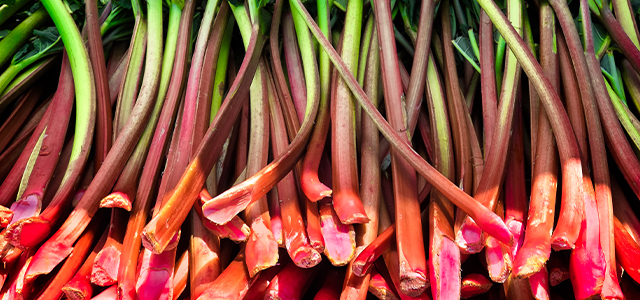Is it true? 5 myths about rhubarb

Green or pink in colour and deliciously sour in taste – rhubarb is an aromatic pleasure. The season for this fruit with the long stalks is short – starting in April, it runs until the middle of June. During this time, we can finally enjoy rhubarb in delicious cakes, as a dessert or in jam. Rhubarb has many fans but also regularly causes confusion – several supposed facts have sprung up about this versatile perennial. True or false? We decode the 5 biggest myths about rhubarb.
Myth 1: Rhubarb is a fruit
Well, you could actually assume that rhubarb was a fruit. After all, like many fruits, it is used in sweet dishes and baked goods. It also tastes slightly sour. However, this myth is false – botanically speaking, rhubarb is a vegetable! More precisely, it is a stem vegetable, which means that mostly the fleshy stem is eaten. Interestingly, asparagus and celery are also stem vegetables.
Myth 2: Raw rhubarb is poisonous
A well-known myth – but not quite true. Raw rhubarb in itself is not poisonous. However, it does contain a lot of oxalic acid. When eaten, the oxalic acid binds with minerals like sodium or calcium and impairs the mineral balance in the body. This applies particularly to the combination of oxalic acid and calcium – it can cause kidney stones and interfere with the absorption of nutrients, such as iron, from food. Therefore, rhubarb should either be cooked or consumed only in small quantities if eaten raw. During cooking, most of the oxalic acid is discharged into the cooking water. Tip: Combine rhubarb with calcium-rich food, such as quark, as it binds the oxalic acid.
Myth 3: Rhubarb has no calories
Almost true – there is no doubt that rhubarb has very few calories: only around 20 calories in 100 g rhubarb. So if you’re looking for a good all-rounder for cakes and other tasty treats, you have struck it lucky with this delicious stem vegetable. But be careful! Because rhubarb has such a sour taste, some people sweeten it with lots of sugar. This of course significantly increases the calorie count. We all know that, in general, vegetables are low in calories. So feel free to dig in when it comes to healthy and substantial veggie dishes – from tomatoes to radishes.
Myth 4: Rhubarb is good for digestion
One myth that is true! Rhubarb contains lots of soluble fibre, such as pectin, which can stimulate your digestive system. It will also keep you full for longer and promote healthy gut flora. So it’s no surprise that rhubarb is said to have been used in China as a laxative as long ago as 5,000 years. Rhubarb also contains vitamin C, valuable minerals and phytochemicals. Perfect for your health!
Myth 5: The colour of the rhubarb determines the taste
Another myth that is true! Depending on the variety, rhubarb can taste very sour, slightly bitter or mildly sweet. The colour of the stem is an indication of its flavour. So, if it is green, with green flesh, it tastes sour. Red stems with green flesh have a subtly tart taste. Red rhubarb with red flesh has the mildest flavour.
Rhubarb – we look forward to seeing you!
Your Dole Team

